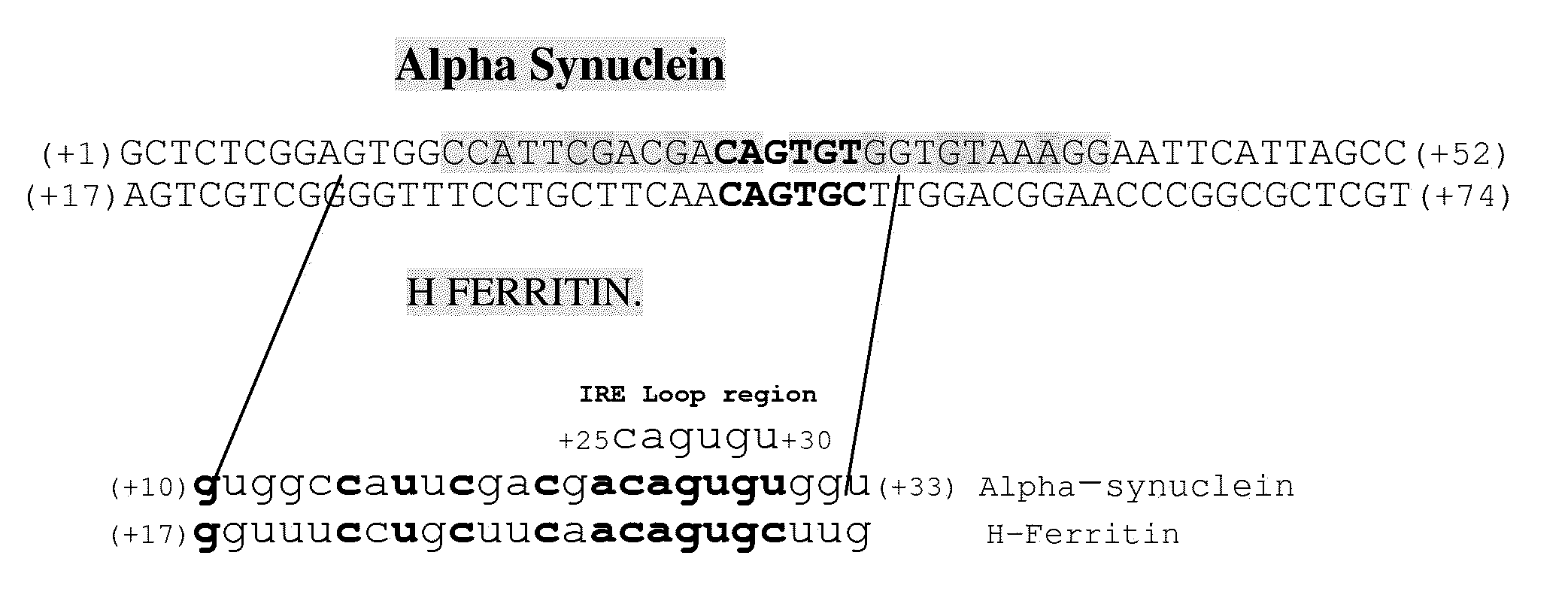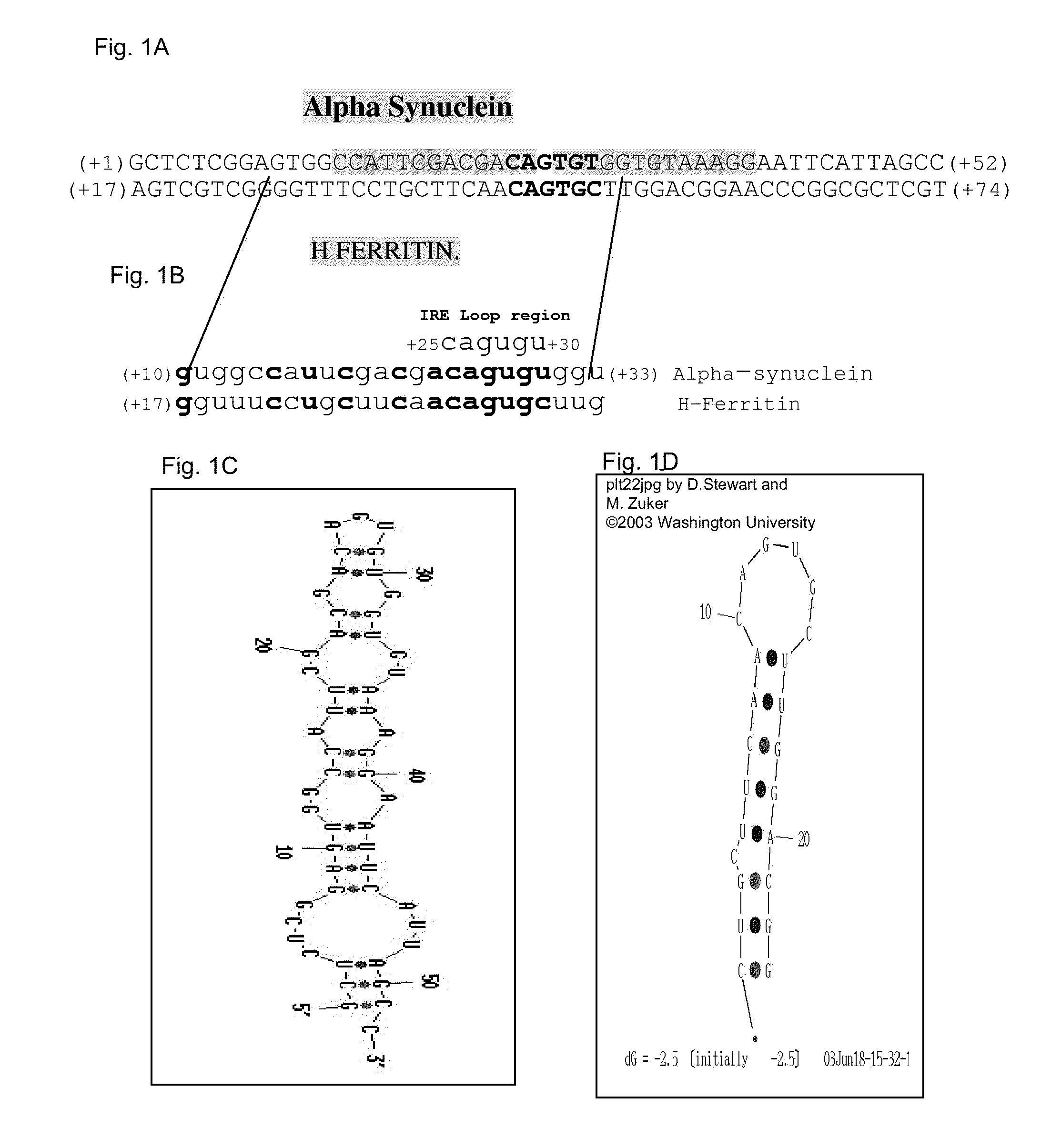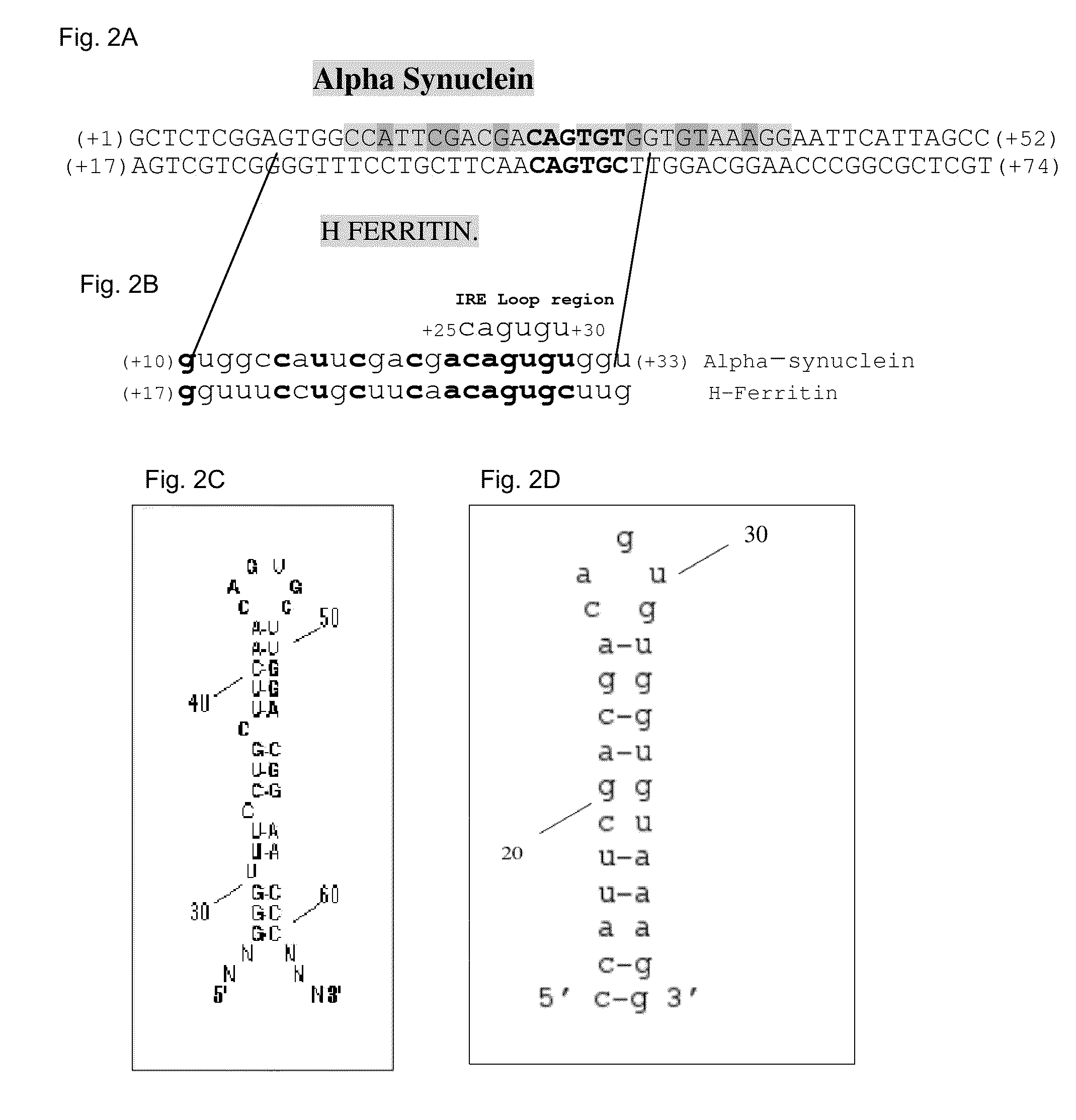Translation Enhancer Elements Of Genes Encoding Human Tau Protein and Human Alpha-Synuclein Protein
a technology of alpha-synuclein and tau protein, which is applied in the field of translation enhancer elements of genes encoding human tau protein and human alpha-synuclein protein, can solve the problems of lack of viable treatment options for the growing number of genes, and achieve the effect of increasing polypeptide production
- Summary
- Abstract
- Description
- Claims
- Application Information
AI Technical Summary
Benefits of technology
Problems solved by technology
Method used
Image
Examples
example 1
Introduction
[0133]We have examined the function of α-synuclein to develop therapeutic strategies to address the pathology of Parkinson's disease. Our results indicate that α-synuclein has a role in iron homeostasis. We have determined that there are putative iron-responsive element (IRE) sequences having RNA secondary structure in a 52 base (SEQ ID NO:1) 5′ untranslated region (5′UTR) of α-synuclein mRNA. By predicting this RNA secondary structure we can screen for RNA targeted drugs that limit the translation of α-synuclein (ASN) driven from the 52 base α-synuclein 5′ untranslated region as a therapeutic strategy for Parkinson's disease.
Methods
[0134]Quantitative Real-Time PCR (qRTPCR)
[0135]Quantitative real-time PCR (qRTPCR) was used to measure steady-state mRNA levels for α-synuclein mRNA relative to transferrin receptor (TfR) mRNA levels in response to iron. Neuroblastoma (SY5Y) cells were treated with iron or desferrioxamine (DFO) for 6 hours or 16 hours and control cells were l...
example 2
[0152]Tau mRNA Regulation by Iron-responsive Elements, a new RNA directed target for AD-based Therapeutics to prevent Neurofibrillary Tangle formation.
BACKGROUND
[0153]Tau is a microtubule-associated protein that is intimately associated with the neurofibrillary tangles of AD (Kosik, K. S., et al., 2002 J. Mol. Neurosci, 19, 261-6). Missplicing of a 4 repeat stretch by alternative Tau mRNA splicing is associated with frontal temporal dementia (Kosik, K. S., et al., 2002 J. Mol Neurosci, 19, 261-6). Altered expression and pathology of Tau is also intimately linked in Supranuclear Atrophy palsy (Kosik, K. S., et al., 2002 J. Mol Neurosci, 19, 261-6) and the iron chelator ferralex prevented Tau tubule formation (Shin et al., 2002 Brain Res. 961:139-46). We have identified three Iron-regulatory Elements (IREs) in the Tau mRNA 3′UTR and two counterparts in the coding region of tau (Bioinformatic search of the human Tau genes (NCBI)) and have used these tau 3′UTR sequences as a valid drug ...
example 3
[0163]Immunoprecipitation RT-PCR (IP RTPCR) experiments were performed using SH-SY5Y neuroblastoma cell lysates to determine specific binding to Iron—Regulatory Protein-1 (IRP-1). α synuclein (ASN) is a 15 kDa protein (monomer) that is ubiquitously expressed in all tissues. However aggregates of ASN cause a profound neurotoxicity in the neurons of the substantia nigra of Parkinson's Disease patients (Sulzer, D. 2001 Nat. Med. 7:1280-1282). There are recessive mutations in the a synuclein protein that cause early onset genetic forms of Parkinson's disease (Papadimitriou, A., et al., 1999 Neurology 52:651-654). Knowledge as to the function of α-synuclein will help in the development of therapeutic strategies to address the pathology of Parkinson's disease. α-synuclein has been found to be up-regulated during MPP+-induced apoptosis in neuroblastoma cells, and transferrin receptor, iron and hydrogen peroxide were intermediates (Kalivendi, S. V., et al. (2004). J Biol Chem 279, 15240-152...
PUM
| Property | Measurement | Unit |
|---|---|---|
| volume | aaaaa | aaaaa |
| volume | aaaaa | aaaaa |
| volume | aaaaa | aaaaa |
Abstract
Description
Claims
Application Information
 Login to View More
Login to View More - R&D
- Intellectual Property
- Life Sciences
- Materials
- Tech Scout
- Unparalleled Data Quality
- Higher Quality Content
- 60% Fewer Hallucinations
Browse by: Latest US Patents, China's latest patents, Technical Efficacy Thesaurus, Application Domain, Technology Topic, Popular Technical Reports.
© 2025 PatSnap. All rights reserved.Legal|Privacy policy|Modern Slavery Act Transparency Statement|Sitemap|About US| Contact US: help@patsnap.com



